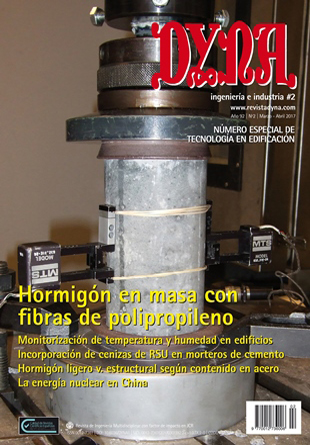DESIGN OF A MODULAR LOW-ENERGY BUILDING SYSTEM FROM A COMPOSITE MATERIAL BASED ON WOOD FIBERS AGGLOMERATED WITH CEMENT
Keywords:
Material Compuesto, Fibras de Madera, Resistencia a Flexión, Resistencia a Compresión, Resistencia a Tracción, Conductividad Térmica, Estándar Passivhaus, Caracterización higrotérmica, Microscopía Electrónica de Barrido, Composite Material, Wood Fibers, , Thermal Conductivity, Passivhaus Standard, Hygrothermal Characterization, Structural Characterization, Modular Building System, Scanning Electron Microscopy.Abstract
This paper will present the results obtained from the characterization of a 400 kg/m3 density composite material formed by wood fibers agglomerated with cement, for its use as a structural element on a constructive modular system. To realize the mechanical characterization, several bending and compression tests were performed on the three spatial directions due to the fibers’ orientation. The design and characterization of the junctions between modules were studied with tensile tests performed on 10 cm diameter steel rods inserted to the composite material not deeper than 30 cm and with different adhesives. The union between the fibers and cement was studied through the analysis of composite-material samples under an X-Ray Scanning Electron Microscope. The compressive strength rounds the 0,3 MPa, depending on the direction on which the load is applied, and the bending strength the 0,47 MPa. These results allow the material to be used as a structural element in housings with no more than 2 floors. The joints arranged with quick-setting and silicon carbide mortar show a tensile strength of 100 kp. The thermal conductivity has a value of 0,128W/mK in an environmental humidity of 60%. The cement used as agglomerate appears to be forming little isolated lumps that allow the material to have an elevated porosity and as a consequence, a high thermal isolation capacity. Based on this study, a complementary analysis on the constructive system was also carried out in order to make it possible to fit it into the Passivhaus demands. Keywords: Composite Material, Wood Fibers, , Thermal Conductivity, Passivhaus Standard, Hygrothermal Characterization, Structural Characterization, Modular Building System, Scanning Electron Microscopy.Downloads
Published
2017-03-01
Issue
Section
ARTICULOS

